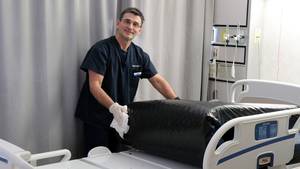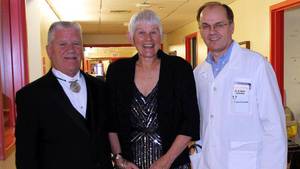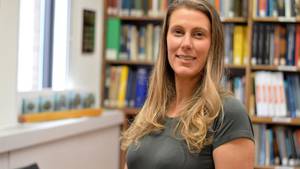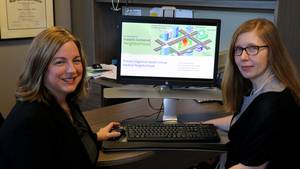Most people recognize anesthesiology as a branch of medicine dedicated to caring for patients during surgical procedures. But what isn’t as well known is that the practice is moving further into every stage of the process, from the lead-up to surgery, through the procedure and into recovery. They are also frequently called to assess critically ill patients and some are involved in critical care.
According to Dr. Blaine Kent, site chief for the Halifax Infirmary’s Department of Anesthesia Pain Management and Perioperative Medicine at the QEII, this offers patients the highest possible level of care.
“We assess people with medical conditions to ensure that they’re physically ready for surgery,” he says. “This may include referring patients to see other specialists if further testing is required, such as a referral to a cardiologist for a stress test or cardiac catheterization to evaluate heart disease.”
As Dr. Kent explains, this helps anticipate and mitigate possible complications and delays.
“For example, if a patient’s hemoglobin is low we’ll get it back to normal in order to avoid potential downsides or risk cancelling an elective surgery.”
Leading up to and during the procedure, anesthesiologists strive to make patients as comfortable as possible.
“We either use general anaesthesia to put your entire body to sleep or use a spinal or regional block, which are local anesthetics injected into the body to block a nerve or nerves,” Dr. Kent details. “We also look after any anxiety with medications for patients undergoing a block or a procedure with sedation.”
Anesthesiologists also play a critical role in the post-operative process.
“We look after patients in the recovery room until they either go home or they go up to the inpatient floor,” Dr. Kent illustrates.
In some cases, tiny catheters can be left in which continue to dispense local anesthesia for hours or days afterwards.
“This cuts down on complications as well as the amount of medication they have to take,” says Dr. Kent.
The QEII’s Department of Anesthesia is also at the vanguard of several cutting-edge initiatives, such as the establishment of a dedicated block room. This is where specially trained anesthesiologists use real-time ultrasound guidance to guide a needle near a nerve and inject medication that “freezes” or blocks it for several hours or up to almost a day.
“This increases our overall efficiency because the blocks can be done ahead of time instead of in an operating room,” he explains. "Where the vast majority of our blocks are ultrasound-guided, our success rate is very high.”
Challenging heart surgeries such as mitral valve repair are also made possible with ultrasound technology, which is used to constantly monitor the patient’s heart functions.
“Rather than replace a mitral valve with a prosthetic valve we can, in many cases, repair the patient’s own valve,” Dr. Kent illustrates. “But this can’t be done without real-time assessment before, during and after they’ve fixed it.”
Another procedure performed at the QEII is Transcatheter Aortic Valve Implantation, or TAVI for short. In this method, a new aortic valve can be implanted via catheter through a large blood vessel in the groin or through a small incision in the chest.
“This is performed under general anaesthesia and we are moving towards doing this procedure with deep sedation,” Dr. Kent explains.
Aided by anesthesiologists, QEII’s neurosurgeons are also doing world-class work in the realm of deep brain stimulation for Parkinson’s patients.
“It’s helpful to have the patients awake while implanting electrodes for that procedure,” says Dr. Kent. “This requires very specialized anesthetic techniques to keep the patient comfortable.”
Given its impressive stable of hyper-specialized anesthesiologists, the QEII is uniquely equipped to handle a myriad of different health challenges.
“We’ve developed close relationships with these other surgical, nursing and allied health professional teams so we can optimize the patient experience,” Dr. Kent maintains.
This familiarity results in a special sort of synergy.
“We’re very familiar with the surgeons and their techniques and know what the special needs are for particular surgeries,” says Dr. Kent. “We can analyse all of the factors, including the patients’ wishes, and tailor the best and safest path through an operation using either a general anesthetic or sedation, whichever is most appropriate.”
This unique combination of resources makes the QEII the main regional centre in the Maritimes for these procedures.
“We’re the only centre this side of Montreal or sometimes even Toronto that can do many of these things. We’ve developed a team of people that can handle pretty much anything that can be thrown at us including all organ transplants except for lungs.”
Looking towards the future, the anesthesiology team is helping to develop Atlantic Canada's first hybrid operating room as part of the QEII Foundation’s $4-million From the Heart campaign.
A hybrid OR allows specialists from several areas of care to work together to provide the best patient care, in one place — diagnosing, treating and intervening all at the same time. This is especially important when treating trauma patients or if an emergency situation arises in the OR; patients will not need to be transferred between health centre floors and care teams, saving critical time when it matters most.







